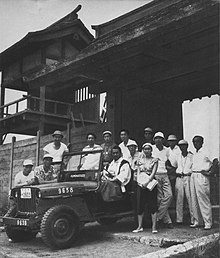Fumio Yanoguchi
Fumio Yanoguchi | |
|---|---|
 | |
| Born | (1917-09-29)29 September 1917 |
| Died | 15 January 1985(1985-01-15) (aged 67) |
| Nationality | Japanese |
| Occupation | recording engineer |
Fumio Yanoguchi (Japanese: 矢野口 文雄, Hepburn: Yanoguchi Fumio, 29 September 1917 – 15 January 1985[1][2]) was a Japanese recording engineer known for his work with film director Akira Kurosawa.
Yanoguchi began working with Kurosawa on the 1949 film Stray Dog, and afterwards began recording the sound for the vast majority of Kurosawa's films until dying late in the production of Ran in 1985.[1] He won the Mainichi Film Award for Best Sound Recording for the 1952 film Ikiru.[3] Yanoguchi also worked on Godzilla films such as Mothra vs. Godzilla (1964)[4] and Godzilla vs. Gigan (1972).[5]
Filmography
His work includes:[6]
- Stray Dog (1949)
- Ikiru (1952)
- Seven Samurai (1954)
- I Live in Fear (1955)
- The Lower Depths (1957)
- Throne of Blood (1957)
- The Hidden Fortress (1958)
- The Bad Sleep Well (1960)
- High and Low (1963)
- Mothra vs. Godzilla (1964)
- Dodes'ka-den (1970)
- Godzilla vs. Gigan (1972)
- Godzilla vs. Mechagodzilla (1974)
- Kagemusha (1980)
- Ran (1985)
References
- ^ a b Akira Kurosawa, Akira Kurosawa: Interviews, University Press of Mississippi, 2008, p. 128, ISBN 1578069971.
- ^ "Yanoguchi Fumio". Kotobanku (in Japanese). Asahi Shinbun. Retrieved 27 January 2017.
- ^ Stuart Galbraith IV, The Toho Studios Story: A History and Complete Filmography, The Scarecrow Press, 2008, p. 88.
- ^ Steve Ryfle, Japan's Favorite Mon-star: The Unauthorized Biography of 'The Big G', ECW Press, 1998, p. 355, ISBN 1550223488.
- ^ Ryfle, p. 359.
- ^ "Fumio Yanoguchi". British Film Institute. Archived from the original on 2 February 2017. Retrieved 19 January 2017.
- v
- t
- e
- Shigeharu Yasue (1947)
- Saburō Ōmura (1948)
- Masakazu Kamiya (1949-1950)
- Masao Fujiyoshi (1951)
- Fumio Yanoguchi (1952)
- Iwao Ōtani (1953)
- Hisao Ōno (1954)
- Hisashi Shimonaga (1955)
- Yukio Kaihara (1956)
- Hirokazu Iwata (1957)
- Saburō Senoyoshi (1958)
- Fumio Hashimoto (1959)
- Masakazu Kamiya (1960)
- Masao Ōsumi (1961)
- Hideo Nishizaki (1962)
- Masao Fujiyoshi (1963)
- Koshirō Jinbo (1964)
- Toshihiko Inoue (1965)
- Masao Fujiyoshi (1966)
- Toshio Tanaka (1967)
- Tetsuo Yasuda (1968)
- Kenichi Benitani (1968)
- Hideo Nishizaki (1969)
- Tsuneo Furuyama (1970)
- Hideo Nishizaki (1971)
- Mutsutoshi Ōta (1972)
- Takaya Sugiura (1973)
- Hideo Nishizaki (1974)
- Yukio Kubota (1975)
- Tetsuya Ōhashi (1976)
- Hiroshi Nakamura (1977)
- Yukio Kubota (1978)
- Shōtarō Yoshida (1979)
- Kenichi Benitani (1980)
- Shōtarō Yoshida (1981)
- Fumio Hashimoto (1982)
- 呂慶昌 (1982)
- Kenichi Benitani (1983)
- Kazuhisa Takahashi (1984)
- Fumio Hashimoto (1985-1986)
- Toyohiko Kuribayashi (1987)
- Ichirō Tsujii (1988)
- Masatoshi Yokomizo (1989)
- Shōhei Hayashi (1989)
- Hideo Nishizaki (1990)
- Senji Horiuchi (1991)
- Tsutomu Honda (1992)
- Yoshio Horiike (1993)
- Manabu Kakuhata (1993)
- Yasuo Hashimoto (1993)
- Kiyoshi Kakizawa (1994)
- Tetsuo Segawa (1995)
- Sōichi Inoue (1996)
- Isao Suzuki (1996)
- Kōichi Hayashi (1997)
- Hiromichi Kōri (1998)
- Yasuo Hashimoto (1999)
- Fumio Hashimoto (2000)
- Osamu Onodera (2001)
- Kiyoshi Kakizawa (2001)
- Kazumi Kishida (2002)
- Mitsugu Shiratori (2003)
- Yutaka Tsurumaki (2004)
- Masatoshi Yokomizo (2005)
- Mitsugu Shiratori (2006)
- Osamu Onodera (2006)
- Masato Komatsu (2007)
- Satoshi Ozaki (2008)
- Kenichi Ishidera (2009)
- Jun Nakamura (2010)
- Satoshi Ozaki (2011)
- Junichi Shima (2012)
- Masato Yano (2013)
- Ken'ichi Fujimoto (2014)
- Takeshi Ogawa (2015)
- Mitsugu Shiratori (2016)
- Hirokazu Katō (2017)
- Kengo Takasuka (2017)
- Noriyoshi Yoshida (2018)
- Ken'ichi Fujimoto (2019)
- Kazunori Fujimoto (2020)
- Tomoharu Urata (2021)
- Takamitsu Kawai (2022)
- Jun'ichi Shima (2022)
 | This biographical article related to film in Japan is a stub. You can help Wikipedia by expanding it. |
- v
- t
- e











